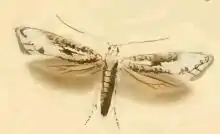| Olive moth | |
|---|---|
 | |
| Scientific classification | |
| Domain: | Eukaryota |
| Kingdom: | Animalia |
| Phylum: | Arthropoda |
| Class: | Insecta |
| Order: | Lepidoptera |
| Family: | Praydidae |
| Genus: | Prays |
| Species: | P. oleae |
| Binomial name | |
| Prays oleae Bernard, 1788 | |
| Synonyms | |
| |
Prays oleae (olive moth) is a moth of the family Plutellidae found in Europe.
Description
The wingspan is 11–15 millimetres (3⁄8–5⁄8 in).
The larvae are a pest on olives (Olea europaea). Other recorded food plants include Phillyrea, jasmine and Ligustrum. They mine the leaves of their host plant which initially consists of an upper-surface, short, narrow corridor.[1]
Distribution
The moth is found in Southern Europe (the Mediterranean region) and North Africa. It was first found in Great Britain at a garden centre in Surrey in 2009 and has since been found at a light trap in Kent.[2]
Gallery
 Leafmines by Prays oleae larvae
Leafmines by Prays oleae larvae Larva
Larva Young larva
Young larva Older larva
Older larva Olive leaves mined by the young larva (2b, 2b*); olive shoot eaten by the mature larva (2b**)
Olive leaves mined by the young larva (2b, 2b*); olive shoot eaten by the mature larva (2b**)
References
- ↑ Ellis, W N. "Prays oleae (Bernard, 1788) small olive ermel". Plant Parasites of Europe. Retrieved 28 March 2020.
- ↑ Kimber, Ian. "22.004 BF449c Prays oleae (Bernard, 1788)". UKmoths. Retrieved 28 March 2020.
This article is issued from Wikipedia. The text is licensed under Creative Commons - Attribution - Sharealike. Additional terms may apply for the media files.